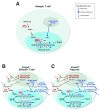Anergy into T regulatory cells: an integration of metabolic cues and epigenetic changes at the Foxp3 conserved non-coding sequence 2
- PMID: 30613389
- PMCID: PMC6305231
- DOI: 10.12688/f1000research.16551.1
Anergy into T regulatory cells: an integration of metabolic cues and epigenetic changes at the Foxp3 conserved non-coding sequence 2
Abstract
Peripheral immune self-tolerance relies on protective mechanisms to control autoreactive T cells that escape deletion in the thymus. Suppression of autoreactive lymphocytes is necessary to avoid autoimmunity and immune cell-mediated damage of healthy tissues. An intriguing relationship has emerged between two mechanisms of peripheral tolerance-induction of anergy and Foxp3 + regulatory T (Treg) cells-and is not yet well understood. A subpopulation of autoreactive anergic CD4 T cells is a precursor of Treg cells. We now hypothesize that phenotypic and mechanistic features of Treg cells can provide insights to understand the mechanisms behind anergy-derived Treg cell differentiation. In this short review, we will highlight several inherent similarities between the anergic state in conventional CD4 T cells as compared with fully differentiated natural Foxp3 + Treg cells and then propose a model whereby modulations in metabolic programming lead to changes in DNA methylation at the Foxp3 locus to allow Foxp3 expression following the reversal of anergy.
Keywords: Anergy; CNS2 methylation; Foxp3; Peripheral tolerance; Treg differentiation.
Conflict of interest statement
No competing interests were disclosed.No competing interests were disclosed.No competing interests were disclosed.
Figures


References
-
- Sakaguchi S, Sakaguchi N, Asano M, et al. : Immunologic self-tolerance maintained by activated T cells expressing IL-2 receptor alpha-chains (CD25). Breakdown of a single mechanism of self-tolerance causes various autoimmune diseases. J Immunol. 1995;155(3):1151–64. - PubMed
Publication types
MeSH terms
Substances
Grants and funding
LinkOut - more resources
Full Text Sources
Research Materials

